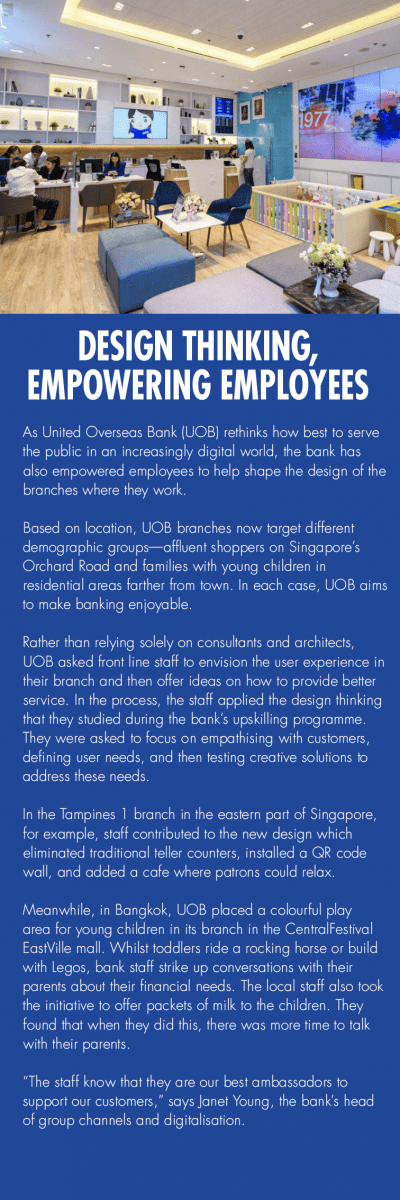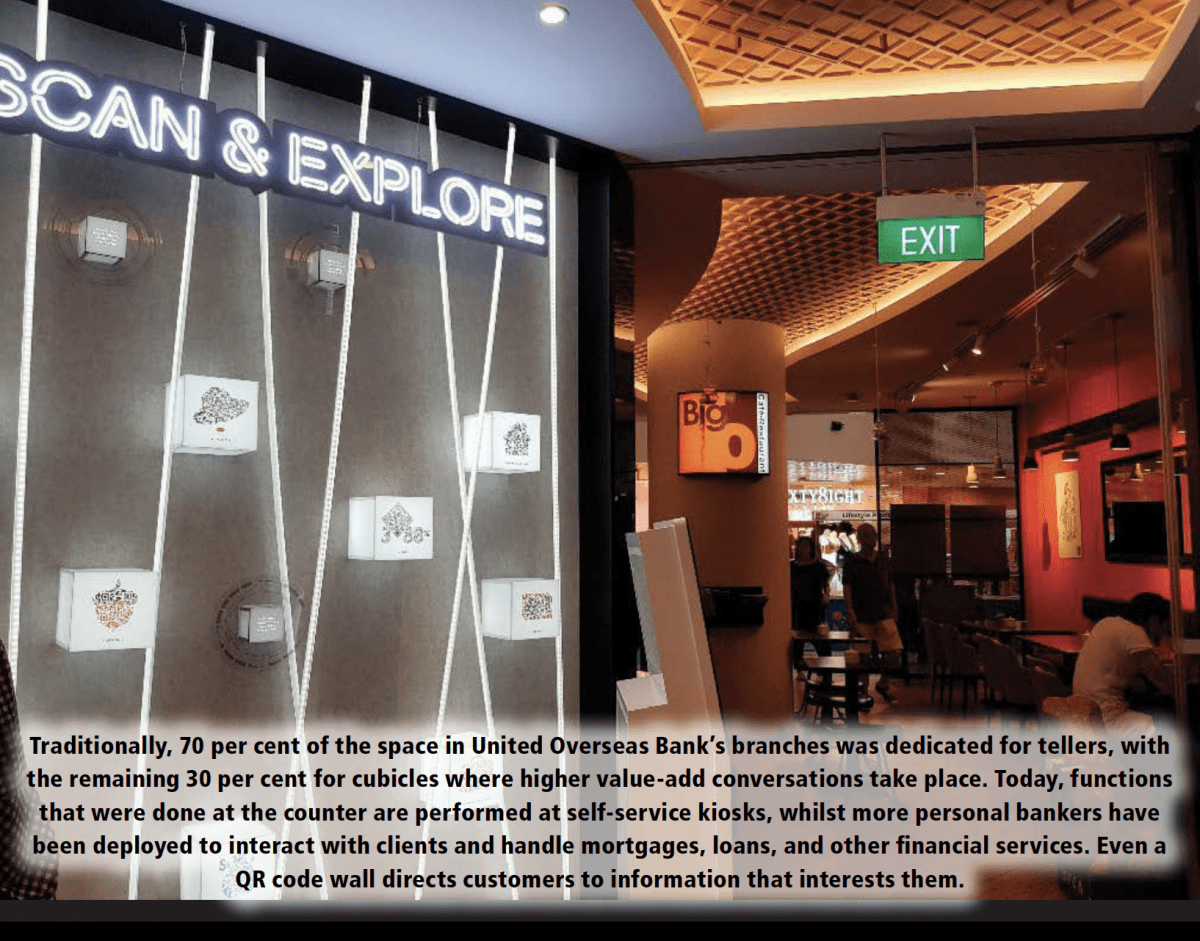United Overseas Bank is retraining its employees and empowering them to shape the future of their workplace.
By Michael Switow
United Overseas Bank (UOB), one of southeast Asia’s largest banks, is transforming the way it interacts with clients.
Traditionally, 70 per cent of the space in its branches was dedicated for tellers, with the remaining 30 per cent for cubicles where higher value-add conversations take place. Today, UOB has completely done away with tellers in one of its largest branches. Functions that were done at the counter are now performed at self-service kiosks, whilst more personal bankers have been deployed to interact with clients to discuss mortgages, loans, and other financial services. A QR code wall directs customers to information that interests them.
“You could have been hired as a bank teller and become an expert teller over time,” says UOB’s Head of Group Channels and Digitalisation Janet Young, but that “single skill” is no longer sufficient. Branch employees are expected to understand data analytics, empathise with customer needs, and be able to explain bank products.
That’s a completely different set of skills than what Audrey Gan needed when she first started working in a UOB branch over 40 years ago -a time before ATMs had been introduced, when clients still telephoned to ask about their bank balance, and when her job was largely transactional in nature, accepting deposits and cashing cheques.
Not only has technology changed since then, but consumer preferences have as well. Mobile banking is in, queueing at a bank counter is out. Ninety-four per cent of UOB customer transactions took place on digital platforms last year. Yet bank branches remain an important touch point for community engagement and higher value-added transactions.
 To address these changes, UOB launched a “Professional Conversion Programme” (PCP) to retrain all of its front line staff in Singapore. Soon, it’s rolling out the initiative in Malaysia and Thailand as well. The bank’s longest-serving staff, like Gan, were among the first to participate. She attended courses with names like “Agile Innovation,” “Service Inclusiveness,” “SkillsFuture for the Digital Workplace,” and “Performance through Coaching.”
To address these changes, UOB launched a “Professional Conversion Programme” (PCP) to retrain all of its front line staff in Singapore. Soon, it’s rolling out the initiative in Malaysia and Thailand as well. The bank’s longest-serving staff, like Gan, were among the first to participate. She attended courses with names like “Agile Innovation,” “Service Inclusiveness,” “SkillsFuture for the Digital Workplace,” and “Performance through Coaching.”
The training is a combination of experiential learning, traditional classrooms, and online studies. On average, it takes participants 48 to 96 hours to complete the course over an 18-month period.
“I was excited to learn and acquire new skills that would enable me to stay relevant,” says Gan, who is now an assistant branch manager. “I also felt reassured and grateful that UOB takes care of its people.” She adds the training was “challenging at times” but has enabled her to continue serving customers.
UOB designed the framework of the programme but works with partners to implement it. Company officials would not say how much they are investing in the PCP, but the overall training budget at the bank was S$26 million in 2018.
Bank officials say they are already seeing a good return on their investment. The Tampines branch is making more money and opening more new accounts than other UOB branches of the same size. Revenue is up 20 per cent, operating expenses are down by the same margin, and the number of new accounts -a key driver of future growth -is up 10 per cent. Surveys show customer satisfaction is rising as well.
One of the biggest challenges for Young and her team in rolling out the retraining programme has been rostering. Staff need to be taken off-shift in order to attend courses, but the branches must operate as normal.
Whilst the training is designed to enable staff to meet the requirements of redesigned job roles, some participants migrate to other areas of the bank after completing the programme.
Loh Poh Yong, for example, started out as a branch service manager after graduating from university three years ago. After taking PCP modules on how machine learning and artificial intelligence can be applied in the banking industry, she entered UOB’s group banking business.
As a business financial manager, she advises small business owners on how they can improve their productivity and “grow their business with the relevant financial products and services.”
“The training also helped me to understand the ways in which I can complement the use of such technologies with the warmth of a human touch,” Loh says.
One of keys to the programme’s success has been communication. Young’s team conducted town halls and surveys to ensure that staff understands the changes in consumer behaviour and how the bank is responding. These actions are also linked back to the company’s core values, which stress teamwork and performance excellence.
There are no formal incentives to participate in the programme, but as awareness of industry trends is raised, the bank’s staff understands the need to align themselves to stay relevant.
“We let the staff know that we are all very committed to ensure that our teams are able to remain properly trained and skilled to be prepared to serve our customers of today and tomorrow,” she explains. “I think because we are a very value-based company, there’s a lot of focus on our commitment and ability to unite around a key focus.
“Once we say ‘this is how customers behave’ and ‘this how we can better serve our customers,’ then the staff get it and realise they must acquire these new skills. The industry transforms; our people must transform,” Young says.















